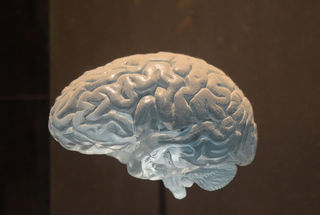Neuroscience
Optogenetics Flaws Reveal Clues About Huntington’s Disease
The axis of neuroscience, AI, optics, genetics and IBM Cloud.
Posted May 21, 2019

Major scientific discoveries and breakthroughs are not always intentional by design. For example, when bacteriologist Alexander Fleming returned from a summer vacation in the autumn of 1928 to an unkempt lab, he discovered that a mold with bactericidal properties had somehow infiltrated his Petri dishes. This chance occurrence led to the discovery of penicillin and the 1945 Nobel Prize in Physicology or Medicine for Fleming, Ernst Boris Chain, and Howard Walter Florey, as well as the first honorary doctorate of medicine in Oxford University’s history awarded to biochemist Norman Heatley for his role in the bulk purification and extraction of penicillin.
Fast forward to the present day in an entirely different field—neuroscience. While conducting research to understand the root causes of Huntington’s disease using state-of-the-art artificial intelligence (AI) hosted in the cloud, a team of researchers discovered an aspect of optogenetics that may impact both existing and future neuroscience experiments, as well as provide insights on neurodegenerative disorders. Published today in the scientific journal Cell Reports, researchers announced the discovery that optogenetic light-stimulation can cause similar reactions in brain cells as observed in Huntington’s disease (HD).
The team of HD researchers from IBM’s Healthcare and Life Sciences, the CHDI Foundation (a biomedical research nonprofit), and the University of California, Los Angeles (UCLA), used optogenetics and a state-of-the-art artificial intelligence (AI) hosted solution.
Optogenetics is a cutting-edge method in which genetic code is added to a target cell, typically a neuron, in order for it to produce light-responsive proteins called opsins. Neurons inserted with opsin from green algae Chlamydomonas reinhardtii, called channelrhodopsin-2 (ChR2), can switch on when exposed to blue light, and switch off when the light was removed. Optogenetics was awarded “Method of the Year 2010” by Nature Method, and is used today in scientific research in behavior sciences, neuroscience, ophthalmology, cardiology, and other fields—it is widely regarded as a gold-standard research technique.
The research team worked together with the lab of Baljith Khakh, Professor of Physiology and Neurobiology at the Geffen School of Medicine at UCLA. Khakh is a leading researcher of astrocytes, a star-shaped non-neuronal glial cell that are the most abundant cell type in the central nervous system.
An earlier study published in Nature Neuroscience in 2014 by Khakh and his fellow researchers showed that a malfunctioning channel in astrocytes can impair its ability to clear extracellular potassium which leads to excess potassium pooling the neurons. This disrupted chemical balance made nearby neurons overly sensitive and fire too easily in lab mice models of Huntington's disease.
For this study, Khakh's lab provided data from 14 optogenetic experiments in which neurons that were stimulated by blue light had subsequent elevated extracellular potassium levels that would later return to the baseline when the light was switched off.
“It was as if these experiments could cause an HD-related cellular response and then reverse it in just about 10 minutes,” wrote Sushmita Allam, M.S., PHD, at IBM Research’s Brain Modeling and Neural Tissue Simulations group, in an IBM Research report.
“We worked closely with CHDI and researchers at UCLA, using IBM Cloud-based modeling to demonstrate—for the first time—that certain light-sensitive proteins introduced into cells within the striatum can trigger the same reactions that are implicated in brain dysfunction in an HD model animal,” wrote Allam in the same report.
The AI machine learning solution was trained on data labeled by the UCLA researchers on the team. According to neuroscientist and IBM Master Inventor James R. Kozloski at IBM's department of Computational Neuroscience and Multiscale Brain Modeling, the team used a cloud-based non-dominated sorting differential evolution (NSDE) algorithm.
“This allowed us to create models of the full range of parameters possible to fit the data, rather than just a single model,” said Kozloski. “It is a state-of-the-art AI hosted solution for all neuronal population modeling problems, including those involving data collected using optogenetics.”
“We found 110,000 unique sets of neuron parameters that were able to reproduce the conditions of light-on and light-off experiments and then replicate the effects of the confounding potassium rise," wrote Allam. "We then used further optimizations to narrow these down to ~1,100 models, each of which closely matched the empirical data."
The researchers demonstrated that optogenetic light stimulations can change the responses of neurons and other cells in the brain which can impact the accuracy of the experiments. The team concludes that in optogenetics, the neuron’s membrane properties, along with the activation and inactivation thresholds for voltage-gated ion channels, are affected by the fluctuations in extracellular potassium; therefore the cellular physiology of astrocytes should be taken into account for this type of neuroscience studies in the future.
“We suggest that cellular neurophysiology is necessary in parallel with in vivo studies in order to make adequate interpretation of neural circuit and behavioral outcomes in studies employing ChR2 and other related optogenetic strategies,” wrote the researchers.
The research team did not set out seeking vulnerabilities in optogenetics, the widely regarded gold standard of neuroscience tools. However, in their scientific quest not only did the pioneering neuroscientists uncover new clues on neurodegenerative disorders like Huntington's disease, but also they made an important discovery that may improve the precision of neuroscience studies that use optogenetics in the future.
Copyright © 2019 Cami Rosso All rights reserved.
References
Rosso, Cami. “Optogenetics — Innovation in Biotechnology and Neuroscience.” Thrive Global. February 23, 2018. Retrieved 5-21-2019 from https://medium.com/thrive-global/how-the-light-and-genetics-may-treat-b…
Allam, Sushmita. “Research Using IBM Cloud and AI Sheds Light on Huntington’s Disease (HD).” IBM. May 21, 2019.
Schmidt, Elaine. “Potassium in brain could be key to fighting Huntington's disease.” UCLA. March 31, 2014.
Markel, Howard. “The real story behind penicillin.” PBS News Hour. September 27, 2013.
Gaynes Robert. “The Discovery of Penicillin—New Insights After More Than 75 Years of Clinical Use.” Emerging Infections Diseases. May 2017.
Nobel Prize Organization. “The Nobel Prize in Physiology or Medicine 1945 was awarded jointly to Sir Alexander Fleming, Ernst Boris Chain and Sir Howard Walter Florey "for the discovery of penicillin and its curative effect in various infectious diseases." Retrieved 5-21-2019 from https://www.nobelprize.org/prizes/medicine/1945/summary/
Evans, Ruth. “Key member of the team that took penicillin from laboratory discovery to mass-produced wonder drug.” The Guardian. January 8, 2004.
Octeau, J. Christopher, Gangwani, Mohitkumar R., Allam, Sushmita L., Tran, Duy, Huang, Shuhan, Hoang-Trong, Tuan M., Golshani, Peyman, Rumbell, Timothy H., Kozloski, James R., Khakh, Baljit S. “Transient, Consequential Increases in Extracellular Potassium Ions Accompany Channelrhodopsin2 Excitation.” Cell Reports. May 21, 2019.




